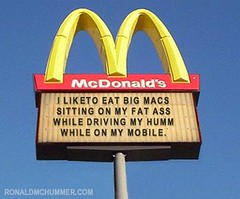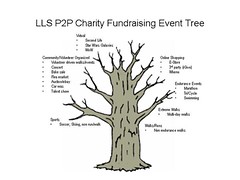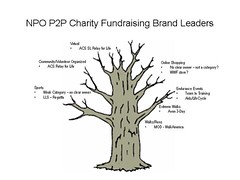I
posted a few weeks ago about Bono asking a question on Yahoo! Answers - and the communal response it evoked (both good and bad).
It turns out, that a few days after that post, our Silicon Valley chapter, in partnership with Yahoo! created a unique opportunity for us to leverage Cindy Crawford's invovlement with our Light The Night campaign to ask a question:
How can we make curing cancer a global priority?
After getting Cindy's approval on this question, we ran around like mad to get everything set up (tracking, infrastructure, coordination with vendors, Yahoo! and internal staff). It's amazing to have seen this come together so quickly. In addition to the core question, the
PSA Cindy cut for us will be running all over Yahoo! for the next few days - driving both Light The Night registrations, and donation activity (we hope).
I do however have to retract something I wrote in my earlier post: Bono did actually participate and visit Yahoo! - I took the cynical view and assumed he did not... oops! Bono really IS THE MAN, although I didn't run into him while in Dublin last week.
I still haven't resolved my question about how we (or any NPO) should get involved in contributing answers to open questions, but from a marketing, publicity and community aspect - Yahoo! Answers is an amazing vehicle.
Speical kudos to the Yahoo! staff who pulled this off (just in case they stumble on this post :))
Tags: nonprofitmarketing, yahoo!, cindycrawford, lightthenight, lls

I can't figure out what McDonalds might be thinking here and LOVE that someone is calling them out with this
neato application. The photo posted is an image I made and uploaded Flick. Word of Mouth cuts both ways (and sometimes deeply).
Which scene in "
Supersize Me" made them think up a promotion with Hummer? Is that a giant "F-you" to the world, or an actual business strategy?
In today's world, when companies don't pay attention, people like
Michael Moore and
Morgan Spurlock do.. and that can't be good.
Tags: nonprofitmarketing, branding, mcdonalds
NPO Marketing in Ireland
I'm about to visit Ireland for some much needed vacation time - so I wondered what Irish charities were up to - what do Irish charity sites look like? I wondered what events do manage and if they have e-mail newsletters, donate now buttons and affiliate shopping sites...
It's always fun to look at how different cultures do similar activities like fundraising, charity and especially marketing and advertising. I grabbed a random sample of Irish charities to see if I could learn anything!
The Irish Cancer SocietyThey have a full featured web site with a ton of cancer content. I love how they feature iconic buttons on the right - the first one being "Just Diagnosed." The home page features a poll, news and key stories. Their
daffodil day fundraising program raised 3.3 million euros - love this bit from the press release:
"the Society made a heart felt plea to the public through the national and local media to come out and dig deep into their pockets and the public responded in force"
Like LLS's site - there is just too much there - it's overwhelming. They are have a mechandise shop and are selling all sorts of merchandise, including wristbands (ack!).
Irish Multiple Sclerosis SocietyAwkward layout with rollovers makes this a hard site to dig into - and unlike the Irish Cancer Society this site feels a bit empty. After digging a bit, I found their "Fundraising section" - which features donations, marathons, MS Swimming, a readathon and christmas cards. I didn't read the annual report, but I do not think that the society is very big in terms of funds raised, for example the swim event raised only 11,000 euros last year.
I was encouraged by the
readathon in terms of looking for a unique, new fundraising concept, but I'm not sure this is it... still can't figure out from the site how they raise money other than through sponsorships.
Finally, the
walk program shows some novelty in that their walks are to places like Peru and Tanzania - but I'm left wondering how it works - I assume partipants have to raise significant funds to go on the trip (like Team In Training), but the site offers no online registration, requirements or any other information!
Barnados: the leading Irish Children's charity
The site is very modern/slick looking and features a ton of great content and information. Like many American charities, they have jumped on personal page fundraising and even feature a "Sponsor Me" link on the homepage. This site feels very familiar, there isn't much here that many/all US charities are doing - I couldn't find any really unique things.
The one thing I didn't see in any of these three sites was any community at all - no message boards or blogs - nothing! I'm a bit surprised, only because basic message boards have been around so long.
I've never been to Ireland - can't wait to get there and out of the office!
Tags: nonprofitmarketing
New Layout and New (Feedster) Feed
Check me out with my fancy new layout!
Update your feed from this site with my new, fancy
feedburner feed as well.
If you have any issues with this oh so cool ajax template, feel free to
email me.
Props to the guys who's link is at the way bottom of the blog, nice job guys!
Watch this
videoblog....
This is the best rant about design I've heard in ages. It's so clever and insightful! It's also something to remember as we move further and further into social networking and "Web 2.0."
(Props to Jerry Paffendorf for showing this clip at the Metaverse Pre-launch party last night)The balancing act between brand "protection" and creative expression is being blurred rapidly and NPO's are going to have to start to understand that in order to create buzz, viral marketing and online success - "
open-source marketing" is a requirement (or soon shall be one).
OK! So who's ready to let donors create your next PSA, banner ad, direct mail campaign? Anyone? Bueller?
Tags: metaverse, nonprofitmarketing, branding, brands, lls, myspace, zefrank
I read a lot of branding books and articles. I love to talk both strategically, tactically and intellectually about branding (yes, I'm a marketing geek).
This Business Week story, if you believe the "branding experts" should officially mark the beginning of the end of Wal-Mart.
Exhibit A:"[Wal-Mart is] updating products and remodeling stores to attract more affluent shoppers"
This marks a departure in their brand promise and how they deliver their retail experience. More affluent shoppers don't want, need or like the current shopping experience at Wal-Mart - that's how Target built THEIR brand. While my comments may contradict the following:
"Wal-Mart studied its customer base closely last year and discovered that many of its shoppers were quite affluent"
I'm betting that even though affluent folks shop at Wal-Mart every so often, it just can't hang as a brand that can deliver an experience that affluent shoppers expect. This seems to me to be a classic blunder that many brands make (confusing what your brand delivers, how it delivers it by watering the brand down with divergent brand strategies).
Perhaps they should create a new brand focused on affluent shoppers that can actually deliver. I was reading an
article in 1 to 1 Magazine (free registration required) about 1-800-Flowers. They've been very smart in how they've built other brands that leverage their infrastructure, but do not conflict with their core brand - building brands like Plow & Hearth, Hearthsong, Popcorn Factory, Greatfood.com and others.
Exhibit B:

"Wal-Mart finally recognized that retail is not just about prices..."
Ok, now this is just silly! Wal-Mart's brand is all about prices - in fact, their own tagline is "Always low prices, Always." I especially love how they emphasize "Always" by putting it twice in the tagline - it's a great touch. Granted, the quote above isn't from Wal-Mart execs - it's from a fund manager, who is hopefully selling stock in Wal-Mart, because if branding history teaches us anything, Wal-Mart's stock value is about to go the wrong way. Oh my god... I just realized that I own stock in Wal-Mart... I must call my broker immediately.
Exhibit C: Wages
Then there is this entire bit about how raising wages will make Wal-Mart an even better place to work, and that the higher wages will allow Wal-Mart to serve "more affluent" customers.
"It's really an image thing," says David J. Abella, portfolio manager at Rochdale Investment Management, which manages more than $2 billion in assets.
This is killing me... So is it a PR/Image thing, or is it brand strategy? I'm a common sense guy... this makes no sense. Let's pay people 6% higher salaries, and we'll suddenly become a great place to work (you need a better PR strategy than!) and affluent customers will beat down our doors because we now have great service, because we pay 6% higher. Ummm, yea.
Exhibit D - The Early Results:Wal-Mart's newer stores' sales per square foot slipped a little in June. Considering these are likely the ones with the new store redesign in place, it's a worrying slip. Yep, sure is worrying!
Charles Grom, an analyst with J.P. Morgan Securities, says that existing stores could see soft sales too, because of the extensive remodeling that will go on over the next few months.
I agree with Barry who says:
"Wal-Mart is trying to have something for everyone and in the process it will lose its current customer"
In writing this post, it's not my intention to bash Wal-Mart - only to analyze their branding strategy out of intellectual curiosity and to see how it applies to my current
employer. Then again, maybe not - maybe Wal-Mart will prove that brand divergence is a false theory making stacks of books obsolete.
So how does this apply to Non-profit marketing? How many times have you taken a floundering campaign and added elements or new types of users only to find that you've taken a step backwards? It takes discipline to step back and look at your brand, figure what it stands for, where it stands in the marketplace and craft a strategy that will raise more money or drive more awareness.
For instance, Team In Training is a fitness brand - and one that appeals to high achievers - folks who want to commit to running a marathon or completing a triathalon and who tend to be female. Those same folks are expected to raise several thousands of dollars as they train for their event! We constantly battle against each other looking for "new marketings" - expanding Team In Training in it's current form 24-year old single males who play video games all day doesn't make sense! If we want to go after that demographic/consumer, then we need a new brand - that's brand divergence - and most likely, the level of training, staff support and fundraising would be significantly different (sounds like a new program to me!)
As for some of my other mistakes - we tried to launch a
Team In Training film school/video mash up site with no luck at all. Why? High achieving females who are busy training for marathons and raising thousands of dollars don't have the time, ability or interest in creating fun, viral videos. Oops :) Hey, we all make mistakes once in a while. Hopefully for Wal-Mart's marketing staff, this isn't a billion dollar branding blunder. Perhaps a better strategy would have been to launch a video remix site for 24 year old video gamers who want to create video game versions of our PSAs in World of Warcraft. Or, maybe not!
What am I missing about Wal-Mart's strategy that makes me look like a fool for posting all this stuff? Comments are open so bring em on!
Tags: nonprofitmarketing, wal-mart, branding
I just finished reading an amazing marketing book by Al & Laura Ries called "
The Origin of Brands." For years working at different Internet start-ups, I was a true believer in the convergence story - media, text, images, content and access will eventually converge into one huge, massive and accessible glob of stuff that will revolutionize the galaxy.
Origin dispels that notion quickly and effectively by using Darwin's theory of divergence. The case the book makes is extremely compelling, and has forced me to start thinking about NPO branding in a new light - at the very least, it's given me a new framework and lens in which to look at things.
Granted, all of the books that I've read that lean on metaphors and analogies seem to come loaded with exceptions (cell/camera phone convergence) that bother me but the overall framework is very solid. The book handily explains these exceptions by pointing out that convergence success stories are mostly predicated on convenience factors (think Pert shampoo conditioner) and that convergence products are limited. I've been sold big time :)
As with all of my posts to this blog, I'll try to apply it to NPO marketing without giving TOO much away (I don't want to get fired any time soon), but enough to allow for some interesting comments and discussion (so post away!).
I created 2 graphics to illustrate divergence within "P2P" (person to person) fundraising:

Graphic 1 (above) depicts overall P2P charity fundraising event categories. These categories include Walks/Runs, Extreme Walks, Endurance Events, Sports, Community/Volunteer, Online Shopping and Virtual.

Graphic 2 (above) attempts to define the brand leaders in each of these categories. One of the things I've taken from the book is how to look for new categories that will emerge from existing categories (divergence). For example, Walks diverged into Extreme walks and Endurance events. The book makes a good point in talking about categories - owning categories is as important as the brand itself. For example, you don't think about drinking a Bud, you first think about having a beer - then immediately (perhaps even instantaneously) about Budweiser.
Interestingly, I think there are direct parallels in Charity event fundraising - I'm not sure that folks think to themselves about doing
WalkAmerica or
Light The Night as much as they think about someone they love who had a premature baby, and that they'd like to do something about that, and that WalkAmerica is the obvious choice. I know from research, that a large portion of our
Team In Training participants are looking for help in running a marathon (training) and only fully understand the mission (cure cancer) during and after doing the event.
Finally, the book lays it out in simple terms how #1 and #2 brands position themselves. Simply put, #2 brands must be different, even opposite the leading brand in order to be successful. The best examples of this from the book include:
Home Depot (Masculine) vs. Lowe's (Feminine)
Coca-Cola (Older People) vs. Pepsi (Younger People)
I'm now taking a look at all of our brands, trying to map them to categories and looking at who are the leaders - if it isn't us - then we'll need to figure out a way to be a solid #2 or (gasp!) get out of the category altogether.
If you are reading this post, feel free to comment - especially on where you see differences in the NPO sector (if there are any). I suspect that many NPO marketers would like to believe this doesn't apply (I'd be happy to disagree and challenge you!).
While writing/spell checking and mulling over this post, I discovered the
official blog/site which today is talking about
Mel Gibson (unreal).
Tags: nonprofitmarketing, brands, lls, branding,




